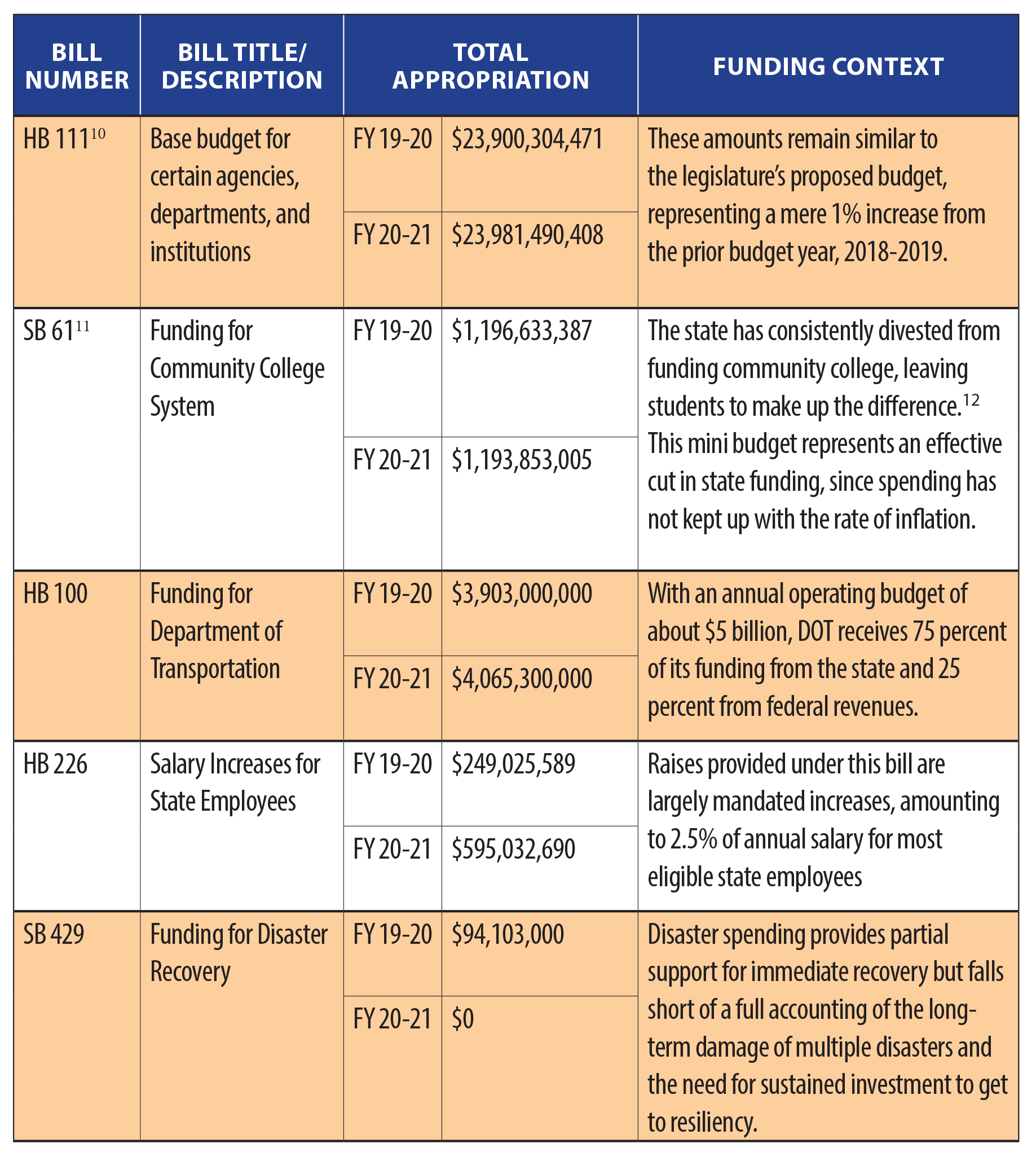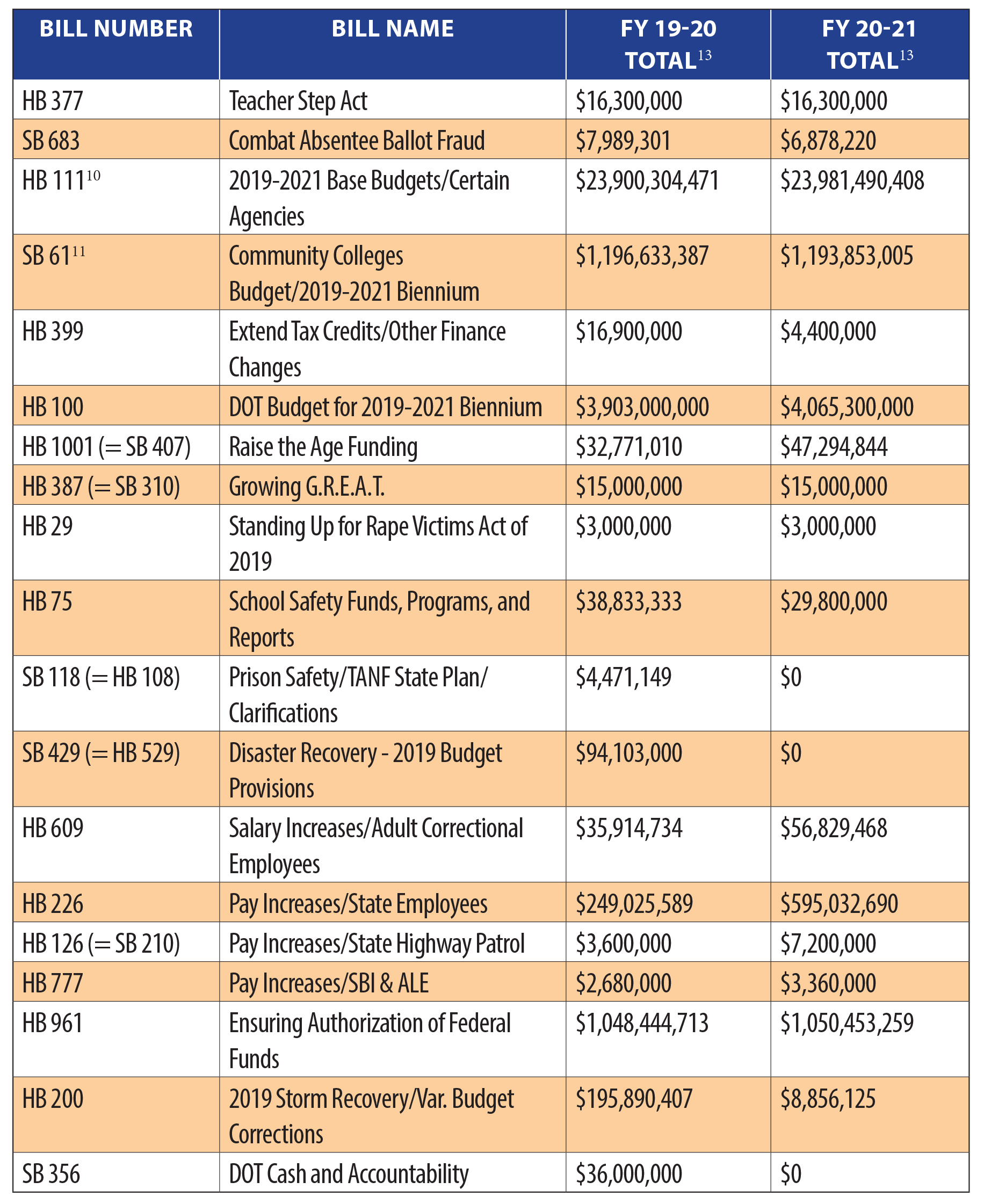Piecemeal budgeting neglects community priorities
Budgets are moral documents. So what values are reflected when the state fails to pass a budget? For the first time in recent history, North Carolina has failed to pass a comprehensive budget. Because the General Assembly refused to adequately fund health and education, North Carolina broke the state budget up into dozens of “mini-budgets,” at least 20 of which have been signed into law (see Appendix). This piecemeal approach caused many pressing priorities to slip through the cracks, leaving working families to pick up the pieces.
State budgets set priorities for how to spend our collective tax dollars. Decisions about how to invest public dollars determine who has access to the goods and services people need to live healthy, productive lives. Since 2013, North Carolina’s self-imposed tax cuts for big corporations and wealthy individuals have slashed revenues, causing communities to fight over smaller pieces of a shrinking pie. The General Assembly’s scarcity mindset has resulted in inadequate funding for many communities’ most pressing needs. With a fairer tax code, North Carolina could adequately fund Medicaid and teacher pay — the very issues that resulted in the 2019 budget veto.
Presently, piecemeal spending decisions largely neglect the needs of communities without wealth and access. Annual budgets provide clarity about state priorities. A piecemeal approach to budgeting fails to provide the certainty that agencies need to be effective, the direction local governments need to plan sustainably, and the opportunity to hold lawmakers accountable to the people they were elected to serve.
What’s at stake?
Without a final budget for fiscal years 2019-2020 (which began on July 1, 2019) and 2020-2021, North Carolina is operating under last year’s spending levels, with few exceptions. As a result, many community needs are going unmet. The following are some of the immediate effects of not passing a state budget.
Public Schools
North Carolina’s legislators are obligated under our State Constitution to ensure that every child has a meaningful opportunity to receive a sound basic education, backed by adequate funding and resources in every public school. Unfortunately, school funding has stayed stagnant, despite growing enrollment numbers. North Carolina continues to face a backlog of over $8 billion in school construction.1 Fixing our crumbling school infrastructure would improve learning environments and generate good jobs. North Carolina’s class of 2021 will have experienced declining state investment for their entire K-12 education experience. Per-student funding is $380 lower than lower than it was before the Great Recession.2 The lack of a comprehensive budget has meant that public schools are expected to operate with no increased dollars to match higher enrollment numbers.
Every teacher should be compensated at a level that acknowledges their contributions to our children and the prosperity of our state. Next year, teachers will go without their annual modest pay raise. Teacher pay in North Carolina remains below $54,000, and North Carolina teachers are paid 26.5 percent less than comparably educated workers in the private sector.3 By comparison, the average basic cost of living for a family of four in the state is approximately $53,000 per year.4 As North Carolina continues to ask teachers to do more with less, many teachers cover more and more class expenses out of their own pockets. Without adequate compensation, we aren’t setting teachers up for success in the classroom or at home.
Health Care
Every person has a right to be healthy by receiving high-quality affordable health services and lifesaving treatments. In summer 2019, the North Carolina General Assembly proposed steep cuts to Medicaid, the key health coverage program for low-income individuals and families, in both its proposed budget bill and in a separate mini-budget. The $42 million cut was avoided through the budget and mini-budget bill vetoes; however, the absence of adequate funds has delayed the shift to Medicaid managed care. This means that 1.6 million North Carolinians — those in the first wave of the major programmatic shift — are likely to experience some disruptions or confusion in how they can access their health care.
In addition to funding for the existing Medicaid population, the legislature has again declined to expand program eligibility for an additional 500,000 low-income North Carolinians, many of whom are currently uninsured. The legislature has yet again failed to do the right thing despite overwhelming evidence comparing states with and without Medicaid expansion that links expansion to fewer deaths (especially for infants and new mothers5),6 fewer hospital closures (particularly in rural areas),7 savings for state budgets,8 and more. By not passing a final budget, our state has missed the opportunity to close the coverage gap and ensure that current Medicaid enrollees get the care they need.
Child-Care Assistance
The ability to afford quality child care helps working parents stay at their jobs and expands access to the early learning children need to reach key developmental milestones. Children need rich developmental environments to be successful later in life. Unfortunately, more than 33,000 children are currently on the waiting list for child-care assistance in North Carolina.9 Families are paying an increasing percentage of their income on child care, which makes it harder to afford the basics like food and housing. Nearly half of young children across the state live in child-care deserts where there aren’t enough providers or slots to serve every child who needs care.
The legislature did not propose a mini budget on child care assistance, which is a pressing need for working families across the state, especially in areas where there are few providers. The child-care assistance waiting lists will not be addressed this year, effectively precluding a cohort of children from a quality early learning experience that could generate significant long-term benefits. Stagnant funding levels are insufficient to keep up with the growing demand as North Carolina is failing to recognize the pressing need to expand access to quality, affordable child care.
Which piecemeal budgets did pass?
The following are a few of the largest “mini budgets” signed by Governor Cooper.
Where do we go from here?
North Carolina cannot let the dangerous precedent of piecemeal budgeting become the new normal. For a state budget to reflect the values of all communities, it must be clear, comprehensive, and transparent. We need to hold our lawmakers to account by urging them to put the public interest ahead of partisan power struggles. In 2020, lawmakers should prioritize:
- Investing in public schools, specifically school construction, teacher pay, and closing the achievement gap in light of the Leandro report.
- Increasing access to health care by fully funding Medicaid expansion and closing the coverage gap.
- Expanding child-care assistance to families without accessible, affordable, quality options.
- Building affordable housing stock by streamlining funding streams and targeting additional resources to communities at risk of displacement.
- Protecting our environment by ensuring all communities have the resources they need to keep the air and water clean for current and future generations.
Without a comprehensive budget, it is even more important that we hold our lawmakers accountable. The best way to ensure that state legislators put the public interest ahead of private interests is to ground policy solutions in community needs. Public investments in education, child care, health, housing, and the environment are the stepping stones toward a more equitable and prosperous North Carolina.
Appendix
To access any of the bills listed below, visit the NC General Assembly’s bill lookup page at www.ncleg.gov/BillLookUp/
FY 20-21 TOTAL13
Footnotes
- Nordstrom, K. & McHugh, P. 2019. Make Space for Learning: Current Options to Meet NC’s School Facility Needs Fall Short of Sustainable Solutions. Accessed at https://www.ncjustice.org/publications/make-space-for-learning-current-options-to-meet-ncs-school-facility-needs-fall-short-of-sustainable-solutions/
- Calculations by NC Justice Center’s Education and Law Project
- NC Department of Public Instruction Division of School Business. 2019. Highlights of the North Carolina Public School Budget, Accessed at http://www.ncpublicschools.org/docs/fbs/resources/data/highlights/2019highlights.pdf; Allegretto, S. & Mishel, L. 2019. The teacher weekly wage penalty hit 21.4 percent in 2018, a record high. Accessed at https://www.epi.org/files/pdf/165729.pdf
- Amount for a family of four comprised of two adults and two children. Kennedy, B. (2019). A standard worthy of North Carolina workers: The 2019 living income standard for 100 counties. Accessed at https://www.ncjustice.org/wp-content/uploads/2019/04/Living-Income-Standard-2019.pdf
- Searing, A. & Cohen Ross, D. (2019). Medicaid expansion fills gaps in maternal health coverage leading to healthier mothers and babies. Accessed at https://ccf.georgetown.edu/wp-content/uploads/2019/05/Maternal-Health-3a.pdf
- Broaddus, M. & Aron-Dine, A. (2019). Medicaid expansion has saved at least 19,000 lives, new research finds. Accessed at https://www.cbpp.org/research/health/medicaid-expansion-has-saved-at-least-19000-lives-new-research-finds
- McHugh, P. & Khachaturyan, S. (2019). Strong medicine: Why Medicaid expansion is the right treatment for rural hospitals, economies. Accessed at https://www.ncjustice.org/wp-content/uploads/2019/08/BTC-REPORT-Rural-Hospitals.pdf
- Khachaturyan, S. (2019). Financing health care for North Carolinians in the coverage gap. Accessed at https://www.ncjustice.org/wp-content/uploads/2019/03/BTC-REPORT-Medicaid-Expansion-Savings.pdf
- Aurelien, M. 2019. New state budget and child care: Looking like another missed opportunity. Accessed at http://pulse.ncpolicywatch.org/2019/06/20/new-state-budget-and-child-care-looking-like-another-missed-opportunity/
- Note the totals listed here are for the base budget portion of the bill only. Other provisions in the bill modify appropriations made in other mini budgets, including Raise the Age.
- HB111 includes funding for the Community College System, $1,168,416399 each in FY 19-20 and FY 20-21. However it also includes a provision, in Section 1.2.(c), which cuts funding appropriated in SB61 upon its passage, from $1.2 million each year to $28,216,988 in FY 19-20, and $25,436,606 in FY 20-21. The combination of Community College System funds from both the amended SB61 and HB111 equal the net appropriations noted in the “total net appropriation” column.
- Program Evaluation Division, North Carolina General Assembly. (2016). Funding for North Carolina’s Community Colleges: A Description of the Current Formula and Potential Methods to Improve Efficiency and Effectiveness. Accessed at https://www.ncleg.net/PED/Reports/documents/CCFunding/CC_Report.pdf. Quintero, J. (2019). How the ‘open doors’ stay open: Funding North Carolina’s community colleges. Accessed at https://nccppr.org/how-the-open-doors-stay-open-funding-north-carolinas-community-colleges/
- Note that the sum of the appropriations does not equal the total state appropriations for either fiscal year. This is because the mini budget bills include transfers between state agencies and fund codes, as well as federal and other receipts.
 Justice Circle
Justice Circle 